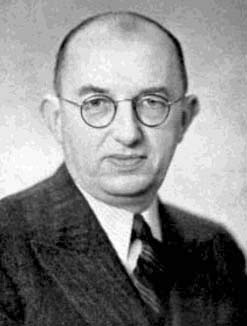


 تاريخ الرياضيات
تاريخ الرياضيات
 الرياضيات في الحضارات المختلفة
الرياضيات في الحضارات المختلفة 
 الرياضيات المتقطعة
الرياضيات المتقطعة
 الجبر
الجبر
 الهندسة
الهندسة 
 المعادلات التفاضلية و التكاملية
المعادلات التفاضلية و التكاملية 
 التحليل
التحليل
 علماء الرياضيات
علماء الرياضيات |
Read More
Date: 18-9-2017
Date: 26-9-2017
Date: 11-10-2017
|
Died: 1968 in Leiden, The Netherlands

Hendrik Kloosterman was brought up as a young boy in the village of Rottevalle which is a small farming village. Although he began his schooling in Rottevalle, he completed his studies at a high school in The Hague.
After graduating from the high school, Kloosterman entered the University of Leiden. Here he studied mathematics and graduated with a Master's degree in 1922. The education he received in the mathematics department was a good one, but the department did not have stars of the quality that worked in Leiden on mathematical physics. Lorentz, although officially retired from 1912, continued to lecture at Leiden and his successor Ehrenfest was an outstanding theoretical physicist whose friends Niels Bohr and Einstein were frequent visitors to Leiden.
Kloosterman continued his studies at Leiden with J C Kluyver as the supervisor of his number theory thesis. It was Ehrenfest, however, who looked after Kloosterman as he would his own students, making sure that he had the opportunity to study with the experts on the subject of his thesis. Ehrenfest arranged for Kloosterman to spend some time in Copenhagen working with Harald Bohr, Niels Bohr's brother.
The topic which Kloosterman was working on for his doctorate was concerned with Waring type problems. Kloosterman was examining the number of solutions in integers xn, to the equation
m = a1x12 + ax2 + ... + asxs2 (*)
The method which Kloosterman was using was based on one due to Littlewood and Hardy so the most natural person to advise Kloosterman was G H Hardy. Again it was due to Ehrenfest that Kloosterman was able to visit Hardy in Oxford.
Kloosterman presented his doctoral thesis to the University of Leiden in 1924. He had managed to find, provided s ≥ 5 and the an satisfy suitable congruence conditions, an asymptotic formula for the number of solution to the equation (*). Under these conditions (1) always has a solution for large values of m. However for s = 4 his application of the Littlewood-Hardy method failed and Kloosterman noted in his thesis that it is rather strange that this powerful technique fails to show Lagrange's result that every positive integer is the sum of four squares.
The case when s = 4 which Kloosterman had failed to solve in his thesis gave him the challenge which he attacked once his PhD had been awarded. His solution of this case appeared in his paper On the representation of numbers in the form ax2 + by2 + cz2 + dt2 which was published in Acta Mathematica in 1926. In this paper Kloosterman introduced what are today called 'Kloosterman sums'. These have proved important in many areas of number theory.
The award of a Rockefeller Scholarship allowed Kloosterman to spend 1926-27 at the University of Göttingen and 1927-28 at the University of Hamburg. During his visit to Hamburg Kloosterman applied his idea of 'Kloosterman sums' to obtain estimates for the Fourier coefficients of modular forms.
After this two years of travel, Kloosterman was offered a post at the University of Münster. He accepted this position and remained there for two years before returning to the University of Leiden in 1930 to a post equivalent to that of associate professor. Springer writes in [4]:-
This was mainly a teaching position. Kloosterman turned out to be an exceptional teacher. He was able to expose with great clarity and great economy the essentials of a piece of mathematics, be it elementary or advanced.
In 1941 the University of Leiden closed during the German occupation of The Netherlands. This in fact presented an opportunity to Kloosterman to undertake research since he had no teaching duties. The university remained closed unto 1945 and the outcome of this period was two major publications on the irreducible representations of finite groups.
The group he studied was the special linear group of 2 by 2 matrices over the ring of integers modulo pn. Schur had solved the problem for the case n = 1, where the matrices are over a prime field, and the case of n = 2 had been solved in the 1930s. Kloosterman solved the general case in two papers The behaviour of general theta functions under the modular group and the characters of binary modular congruence groups which occupy 130 pages of the Annals of Mathematics in 1946.
Kloosterman was promoted to professor at the University of Leiden in 1947, a post he retained until his death.
In [4], as well as looking at Kloosterman's contributions, Springer looks at further developments of his techniques. He writes:-
Although he was not a prolific writer, his work had a significant impact and is still of considerable interest.
Articles:



|
|
|
|
هل يمكن أن تكون الطماطم مفتاح الوقاية من السرطان؟
|
|
|
|
|
|
|
اكتشاف عرائس"غريبة" عمرها 2400 عام على قمة هرم بالسلفادور
|
|
|
|
|
|
|
جامعة الكفيل تقيم ندوة علمية عن الاعتماد الأكاديمي في جامعة جابر بن حيّان
|
|
|